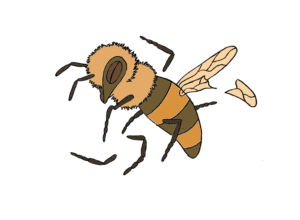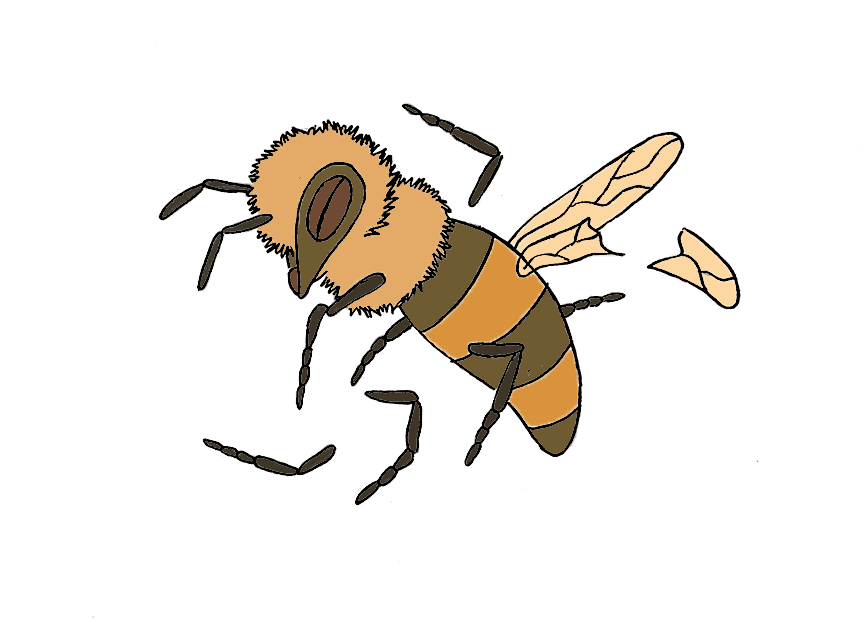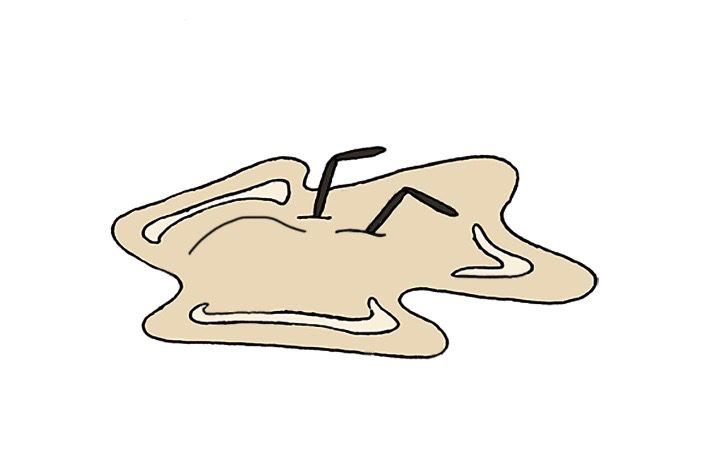
On a warm February day in bright sunshine, I get down on my knees, dig out the earth in my garden, and place my babies into their grave. Their bodies crumble, wings and legs fall off, as I spread them out evenly before covering them with dirt. I weep over my honey bees. Where did I go wrong?
Seven years ago, I stood at the bottom of a steep canyon in Bolivia’s Mizque Province. It was early spring. Fields of quinoa bloomed maroon and thousands of bees flew around me. I held out my arms and watched them dance on my skin. In the local Quechan language, Mizque means sweet and honey, which suited the occasion as I interviewed a Quechan woman about beekeeping. In a conversation translated from English to Spanish to Quechan to Spanish to English, Salome Caceres1 told me about the ecological importance of beekeeping and the economic significance it was having on her life.
Caceres kept several types of hives, one deep in a log, as nature would have it, and several others in bee boxes. Caceres stuck her arm into the log, broke off a piece of honeycomb, and handed it to me. I bit into it and let the warm honey drip down my chin. I had never tasted such sweetness.
February 7, 2018. Two weeks before I bury my bees, I am in Geneva, Switzerland. On a quiet winter’s night with gray skies and a cold drizzle, the moon is missing. The sky is too dark for me to see my breath, but it’s that cold. I’m walking on a bike path near my hotel. I need exercise. I’m jet lagged and can’t sleep. My hands are numb as I fumble to retrieve my phone from my coat pocket. My sixteen-year-old daughter is texting me from Arlington, Virginia. It’s two in the afternoon there.
“Please call my school and tell them I’m not going to any more classes. Brianna2 tried killing herself. The principal knows. You just need to excuse my absence.”
This is not the first time one of Cynthia’s friends has tried committing suicide. I try calling Cynthia. No answer. I text back.
“I’m so sorry, baby. Are you okay?”
Cynthia texts, “I was getting into an Uber to stop her when Brianna’s mom called me from the hospital. It’s been a horrible day.”
Cynthia believed she could save Brianna. I try calling again but get voicemail. I text.
“I need to hear my baby’s voice.”
“I don’t want to talk.”
I want to reach across the ocean and hold my daughter, to pull her hair aside and stroke her cheek like I did when she was younger. I want to keep my baby safe.
Later, I will learn that Brianna cut her arm from elbow to wrist and swallowed a bottle of pills. She nearly bled out. She said goodbye to my daughter and several of her friends through social media. When Brianna arrived at the hospital still conscious, she texted Cynthia a photo of her arms.
Four years had passed from the time I spent in Bolivia’s Mizque Valley to the day I had a hive of my own. In 2015, I ordered my first colony. Eager to learn, I read The Backyard Beekeeper: An Absolute Beginner’s Guide to Keeping Bees in Your Yard and Garden, joined the Northern Virginia Beekeepers Association, and learned how to spot a mite on bee larvae. I started making make bee jokes—“My air bee and bee is open for business”—and signed my emails to fellow beekeepers, “bee kind, bee bold, bee beautiful.”
In the late summer afternoons, I sat on the grass near the hive and watched them beeline their way back home. Sometimes, I would squat right in front of the opening of the hive to watch them carry the pollen in on the back of their legs.
That first year of beekeeping, I harvested four Ragú jars worth of honey. It wasn’t much, but I felt successful, for a while. Several months after harvesting, my bees absconded, disappearing without a trace. There were no mites. They had plenty of honey. I had failed, but there were no clues as to why.
The next spring I bought another hive. Less than a week after I introduced the colony to the bee box, they vanished as well. My bee mentor surmised that this time the queen left to mate and never returned. Without a queen, a colony can collapse.
I ordered another hive. Third time is a charm, I thought. They disappeared, too.
On February 9, 2018, two days after Brianna tried killing herself, a senior at Arlington’s Yorktown High School was found unresponsive on the bathroom floor an hour into the school day. The school immediately went into lockdown. Ambulances and police arrived. Teachers and students were unclear what was happening. One teacher grabbed a child by the arm and pulled him out of the hallway into the classroom and barricaded the door behind him. The teacher feared there was an active shooter in the school. The teacher was not alone. Students were texting their parents. For fifteen minutes, the community believed we were the next Columbine. The next Sandy Hook. The next Virginia Tech. (Five days later, on February 14, 2018, Nikolas Cruz entered Marjory Stoneman Douglas High School in Parkland, Florida, killing seventeen people and wounding fifteen others.)
Police soon reported the incident was self-inflicted. School resumed, and the girl was transported to the hospital in critical condition3. Rumors suggested that the seventeen-year-old hung herself. Others say she overdosed. The family publicly maintains their daughter would not have harmed herself. They say they didn’t see any signs. She died six days later.
Cynthia did not know this girl, but she lived in our neighborhood. This death is close to home.
Each time one of Cynthia’s friends or peers tries killing herself, the experience is compounded. The pain doesn’t get easier.
A few months ago, I walked into Cynthia’s room around ten at night. Her music was too loud, an almost-empty glass of chocolate milk teetered next to her on the bedspread, and her basketball clothes covered the floor. She had a wet towel wrapped around her head and was naked under her covers staring at her computer. Many days I would have nagged her about any one of those things (maybe all) and then asked her if she’d finished her homework. For whatever reason, I asked her how she was doing. I wanted to connect with her. Cynthia wasn’t mindlessly wasting her time but trying to figure out how to comfort her friend Marcia whose best friend had committed suicide the night before.
On November 27, 2017, Jordana “Jojo” Greenberg, sixteen years old, jumped off a bridge onto Massachusetts Avenue in Bethesda, Maryland. My daughter knew Jojo but only through Marcia. Five days later, sixteen-year-old Tommy Silva of Rockville, Maryland, took his life. Marcia knew this boy, too. One week later, Marcia, destitute about Jojo and Tommy, tried to take her own. We are lucky she survived.
The numbers, the names, the days. It’s hard to keep up. One thing is clear. Our children are dying.
According to the Centers for Disease Control and Prevention, teen suicide is on the rise. The suicide rate for males aged fifteen to nineteen years increased thirty-one percent from 2007 to 2015. The rates for females doubled during the same time period. In 2015, a reported 2,061 teens committed suicide in the United States.4 The rise has been attributed to depression, social media, bullying, mental illness, and drugs.
Regardless of the reason, there seems to be a breakdown in connection. Teenagers feel alone and desperate. Their solution: suicide.
I worry about Cynthia, about her stress at school, the anxiety she feels to keep her friends safe, the emotional pressure she feels to be pretty, smart, funny, athletic, and well-liked. Basically, I worry.
When Cynthia was thirteen, she was bullied through the mobile application “Secret,” which allowed people to anonymously post comments within a circle of friends. People she considered friends called her ugly and irrelevant. Cynthia’s sister received even worse bullying. People told my daughter Chloe, on the same app, that she should kill herself. These so-called friends then listed our address and suggested people “to go make a visit.” Chloe was sixteen years old at the time—the same age as Jojo, Tommy, Marcia, and Brianna. Three years later, I still think about the what ifs. The app has since been shut down. But in a climate like this, how do I keep my children safe?
Across the globe, honey bees are dying in droves. Scientists cannot agree on the reason. Pesticides. Climate change. Loss of habitat. Invasive species. Predators. Disease. Stress. Sometimes the bees don’t die but just disappear. This epidemic is colony collapse disorder. Honey bees are social animals. Each bee performs a function for the good of the hive. The bees live and work together, relying on each other for survival. When order is disrupted, when connections are lost, colonies collapse.
The National Academy of Sciences suggests that:
…pressure on young bees to grow up too fast could be a major factor in explaining the disastrous declines in bee populations seen worldwide. Bees usually begin foraging when they are 2–3 weeks old but when bee colonies are stressed by disease, a lack of food, or other factors that kill off older bees, the younger bees start foraging at a younger age.5
Last year, despite my growing discouragement around beekeeping and my increasing awareness of colony collapse disorder, I decided to take on two hives. One was bound to survive.
We had a glorious summer. Me and my bees. The pollen was thick on their hind legs, and the days were long. I harvested two gallons of honey and left more than enough for my bees to feed on all winter. Nevertheless, I wanted to be sure they had plenty of fuel. On a warm autumn day, I fed them sugar syrup. Bees need a resting place when drinking. If their wings get wet, they cannot fly. In manmade hives, beekeepers use floaters, a grooved piece of plastic that floats on the water and allows the bees to rest while taking in the syrup. Although I had only one floater, I decided to put sugar feeders on both boxes. I would order a second floater in the next day or two.
I was not prepared for the mass drowning. I should have known better. Floaters are essential. Still, I was surprised when the second hive—the one with the floater—decided to abscond the same day. What was their reasoning? They gave no warnings.
When the temperatures rose to seventy degrees, I cleaned out my hives. I knew it was going to be a gooey mess. Bees drowned in syrup. I expected fermented bees but was surprised to also find hundreds of dried, dead bees at the bottom of the hive. Did they decide that once their mates drowned in the sugar feeder that their lives weren’t worth living? Or was it because their survival was dependent on the others?
In 2016, the State of Virginia directed its state department of agriculture and consumer services to develop a pollinator protection strategy to promote the health of and mitigate the risks to honey bees and other pollinators.6
I’m encouraged by such measures. Honey bees are an indicator species, meaning that their health is an indicator of the overall health of our larger ecosystem. We are taking the steps needed to keep our bees alive.
Colonies. Communities. Our children are collapsing. Like bees, we are social animals. We need each other. Children are indicators of the health of our society. When a child commits suicide, families are often shamed. People bring food, attend funerals, but they also whisper. They want to know how the family didn’t see the warning signs. They want to know why it happened. They are worried it could happen to their child.
Despite all my worries, I do not believe that my child will commit suicide. But how do I really know? Will I see the signs? What will it take for us to reorganize, to reconnect, so that we can stop burying our young? I want answers. For my bees. For my children. Something is out of order.
***
Rumpus original art by Cowboy Rocky.
1. I interviewed Salome Caceres in May 2011 in Mizque, Bolivia. Caceres was a beneficiary of the United States Agency for International Development-funded Integrated Food Security Project in Bolivia.↩
2. Names have been changed to protect privacy.↩
3. Arlington County Police Department Twitter feed.↩
4. CDC. National Vital Statistics System, mortality data. https://www.cdc.gov/nchs/nvss/deaths.htm.↩
5. Failure of stressed honey bee colonies, Clint J. Perry, Eirik Søvik, Mary R. Myerscough, Andrew B. Barron, Proceedings of the National Academy of Sciences Mar 2015, 112 (11) 3427-3432; DOI:10.1073/pnas.1422089112↩
6. http://www.ncsl.org/research/environment-and-natural-resources/pollinator-health.aspx↩







